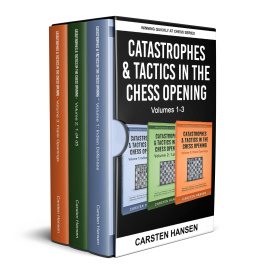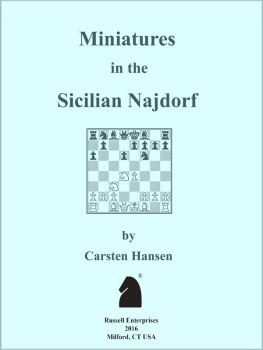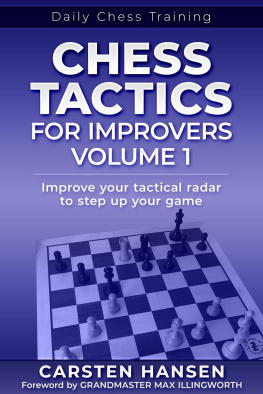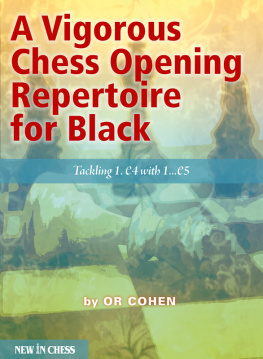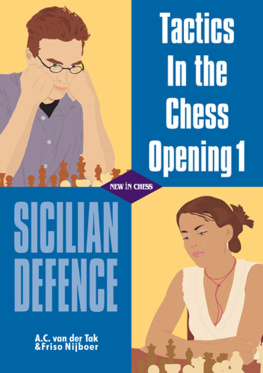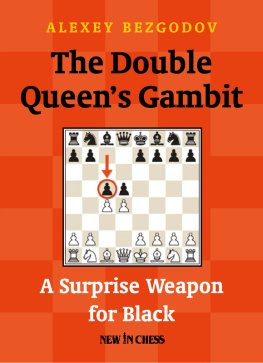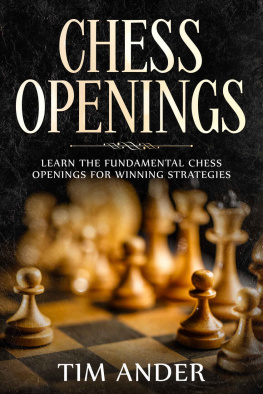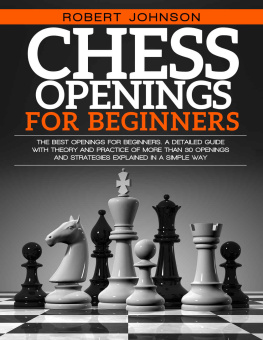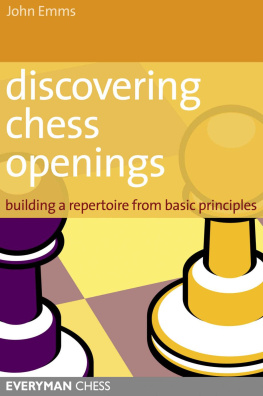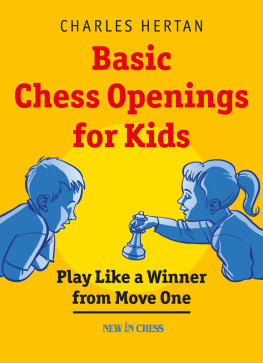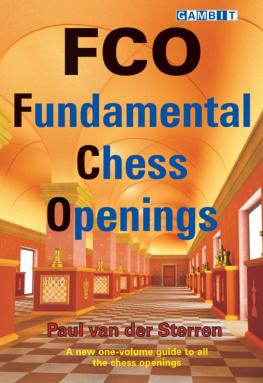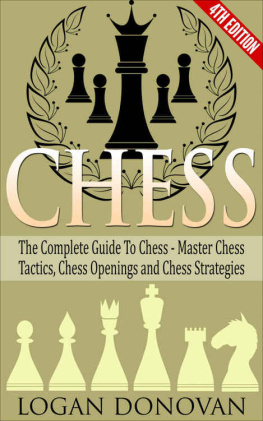Catastrophes & Tactics in the Chess Opening - Boxset 1
Winning Quickly at Chess Box Sets, Volume 1
Carsten Hansen
Published by Carsten Hansen, 2020.
While every precaution has been taken in the preparation of this book, the publisher assumes no responsibility for errors or omissions, or for damages resulting from the use of the information contained herein.
CATASTROPHES & TACTICS IN THE CHESS OPENING - BOXSET 1
First edition. January 16, 2020.
Copyright 2020 Carsten Hansen.
ISBN: 978-8793812475
Written by Carsten Hansen.
10 9 8 7 6 5 4 3 2 1

Winning Quickly at Chess: Catastrophes & Tactics in the Chess Opening - Boxset 1:
Volumes 1-3:
Indian Defenses, 1.d4 d5 & Flank Openings
Chess Tactics, Brilliancies & Blunders in the Chess Opening
By Carsten Hansen


W inning Quickly at Chess: Catastrophes & Tactics in the Chess Opening - Boxset 1: Volumes 1-3: Indian Defenses, 1.d4 d5, & Flank Openings
Copyright 2020 by Carsten Hansen
All rights reserved.
This book or any portion thereof may not be reproduced or used in any manner whatsoever without the express written permission of the publisher except for the use of brief quotations in a book review.
Printed in the United States of America
ISBN 978-87-93812-47-5 (e-book edition)
CarstenChess
40 Kennedy Blvd
Bayonne, NJ 07002
www.WinningQuicklyatChess.com
Contents
T hanks for picking up this book. I sincerely hope you will enjoy reading the book as much as I have writing it.
We all dream of winning our games fast, using excellent opening preparation, flashy tactics, and then mate our opponents. However, it rarely goes like that. Usually, the games average around 40 moves, contain enough blunders on both sides to have both you and your opponent horrified after the game. However, what I have found is that many games, even amongst the strongest players, contain errors and mistakes, some quite significant ones, as soon as the players depart the theory that is known to them.
This book, the first volume in a series of nine, aims to take a look at some of those games, but only the ones that are of 15 moves or shorter. Of course, for a game to end within 15 moves, one of the players has to have made one or more serious mistakes. I have left out games where a piece is threatened, and the player forgot to move it, touched the wrong piece or such things. However, I have included games that include typical mistakes, even if they seem banal.
As for the games, they are typically between players with a rating of at least 2350 and often well more than that; you will find games by players rated above 2700 in this book. Furthermore, I have included some older games, but where the players would most certainly have been rated above 2350 if rating had existed at that time.
T he openings covered in this volume are:
The Kings Indian Defense
The Grnfeld Indian Defense
The Queens Indian Defense
The Nimzo-Indian Defense
The Catalan Opening
The Blumenfeld Gambit
The Bogo-Indian Defense
I n opening encyclopedia terms, these openings have the Chess Informant Opening code of D70 through E99.
Should you have any comments, corrections or compliments, please do not hesitate to send them to
Good luck, and enjoy it!
Carsten Hansen
Bayonne, NJ
January 2017
Chapter 1 - The Kings Indian Defense
T he Kings Indian Defense is a very combative opening. Black signals his intentions immediately: he wants to play for a win, preferably in a kingside attack. This simple strategy, of course, is not something White should let his opponent get away with. Complications are likely to ensue rather rapidly. The opening was part of the repertoire of nearly top grandmasters in the 1950s or 1960s. It has since had its ups and downs but is still a trademark defense for Azeri Grandmaster Teimur Radjabov.
Game 1
R.Ponomariov (2727) J.Ivanov (2431)
Villarrobledo 2009
1.d4 Nf6 2.c4 d6 3.Nf3 g6 4.g3 Bg7 5.Bg2 00 6.00 c6 7.b3 Nbd7 8.Bb2 e5
The main lines are 8...Qc7, and 8...Re8.
9.dxe5 dxe5 10.Nxe5 Ng4
10...Nxe5 11.Bxe5 Qxd1 12.Rxd1 Re8 13.f4 Ng4 14.Bxg7 Kxg7 15.Nc3 Ne3 16.Rd2 Bf5 and Black has some compensation for the pawn, but not enough, Kurajica-Barlov, Yugoslavia 1984.
11.Nxd7 Bxb2 12.Nxf8

What is Black's best move: 12...Qa5, or 12...Qxf8? And what is the likely follow-up in each case?
...Qa5
The text move is a losing mistake. After 12...Qxf8 13.Nd2 Nxh2 14.Kxh2 Bxa1 15.Qxa1 Qh6+ 16.Kg1 Qxd2, the chances are about even.
13.Qd2 Qxd2 14.Nxd2 Bxa1 15.Nxg6 Ending up two pawns down, Black resigned.
Game 2
D.Del Rey (2380) L.Bronstein (2425)
Buenos Aires 1993
1.d4 Nf6 2.Nf3 g6 3.c4 Bg7 4.Bg5 Ne4 5.Bf4 c5 6.e3
Or 6.Qc2 Qa5+ 7.Nbd2 Nxd2 8.Bxd2 Qb6 9.e3 d6 10.Bc3 cxd4 11.Nxd4 00 12.Be2 Nc6 with chances to both sides, Berkovich-Yandemirov, Alushta 1993.
6...Qa5+ 7.Nc3
White has also tried 7.Nbd2 cxd4 8.exd4 Nc6 9.Be3 00 10.a3 d5 11.cxd5 Nxd2 12.Qxd2 Qxd5 13.Be2 Na5 14.Rd1 Bd7 and Black has taken control of the game, Galojan-Sanikidze, Yerevan 2004.
7...Nc6 8.Qd3 Nxc3 9.bxc3
9.Qxc3 is my computer's favorite move, but after 9...Qb6 10.000 00 only Black can be better.
9...d6 10.Bg3 00 11.Be2

How should Black proceed?
...cxd4 12.exd4 e5 !
Incredibly, White is all of a sudden in serious trouble.
13.00 Bf5 14.Qe3??
Now White loses without any further ado, but 14.Qd1 Qxc3 leaves Black with a clean pawn up.

